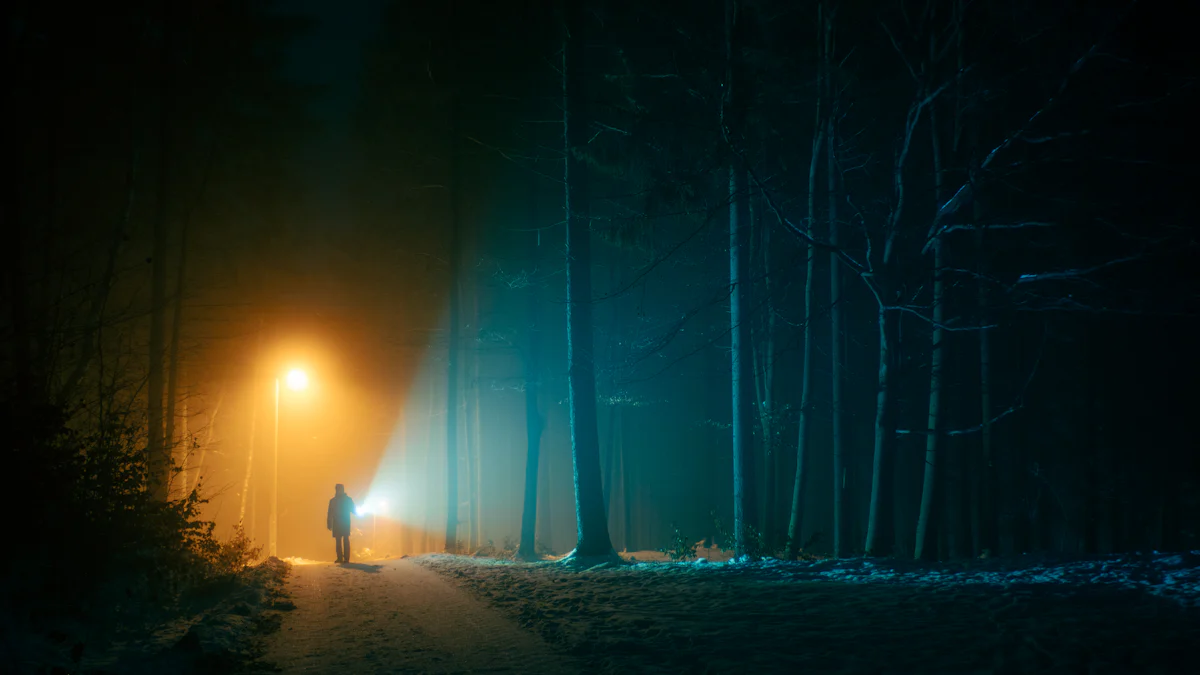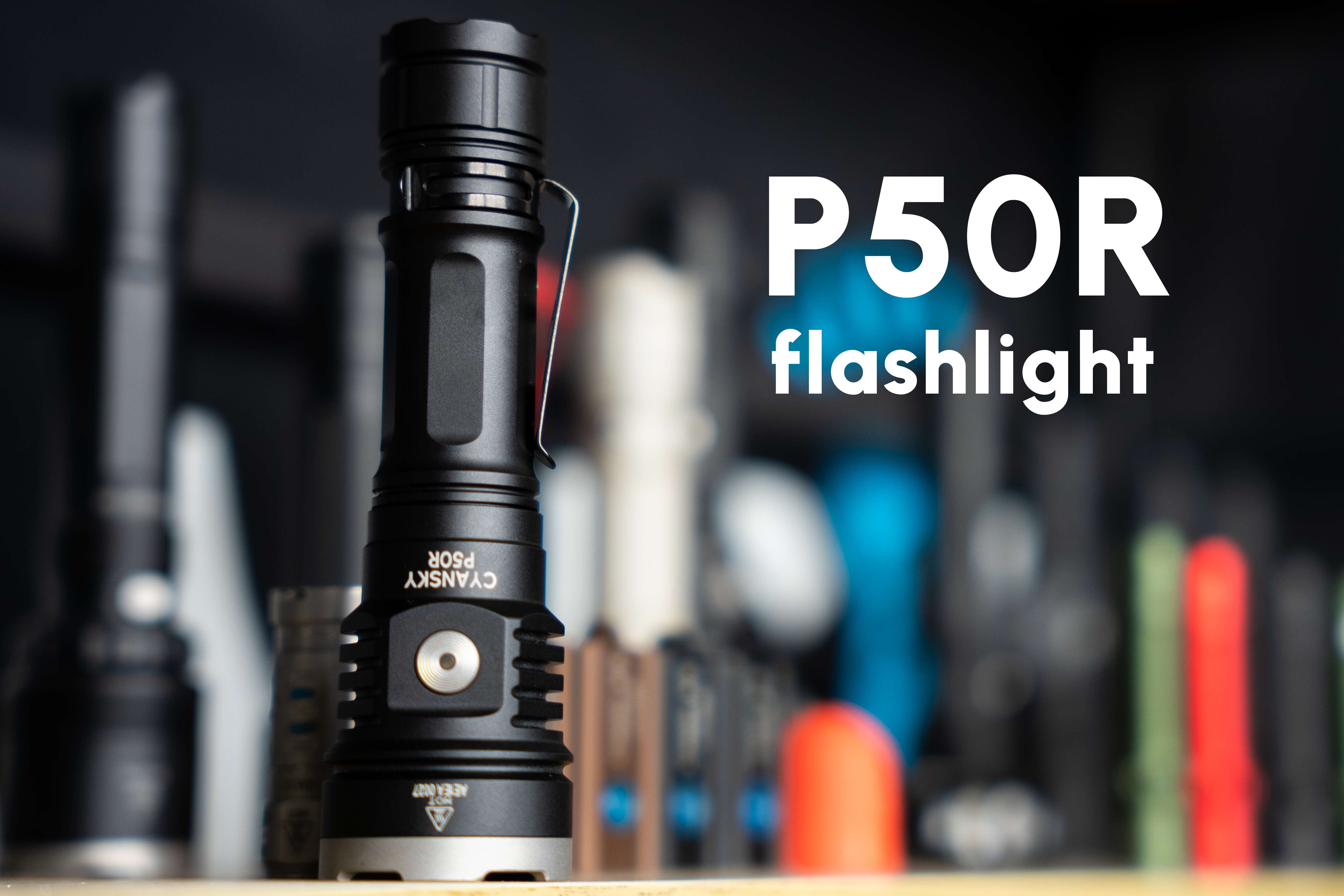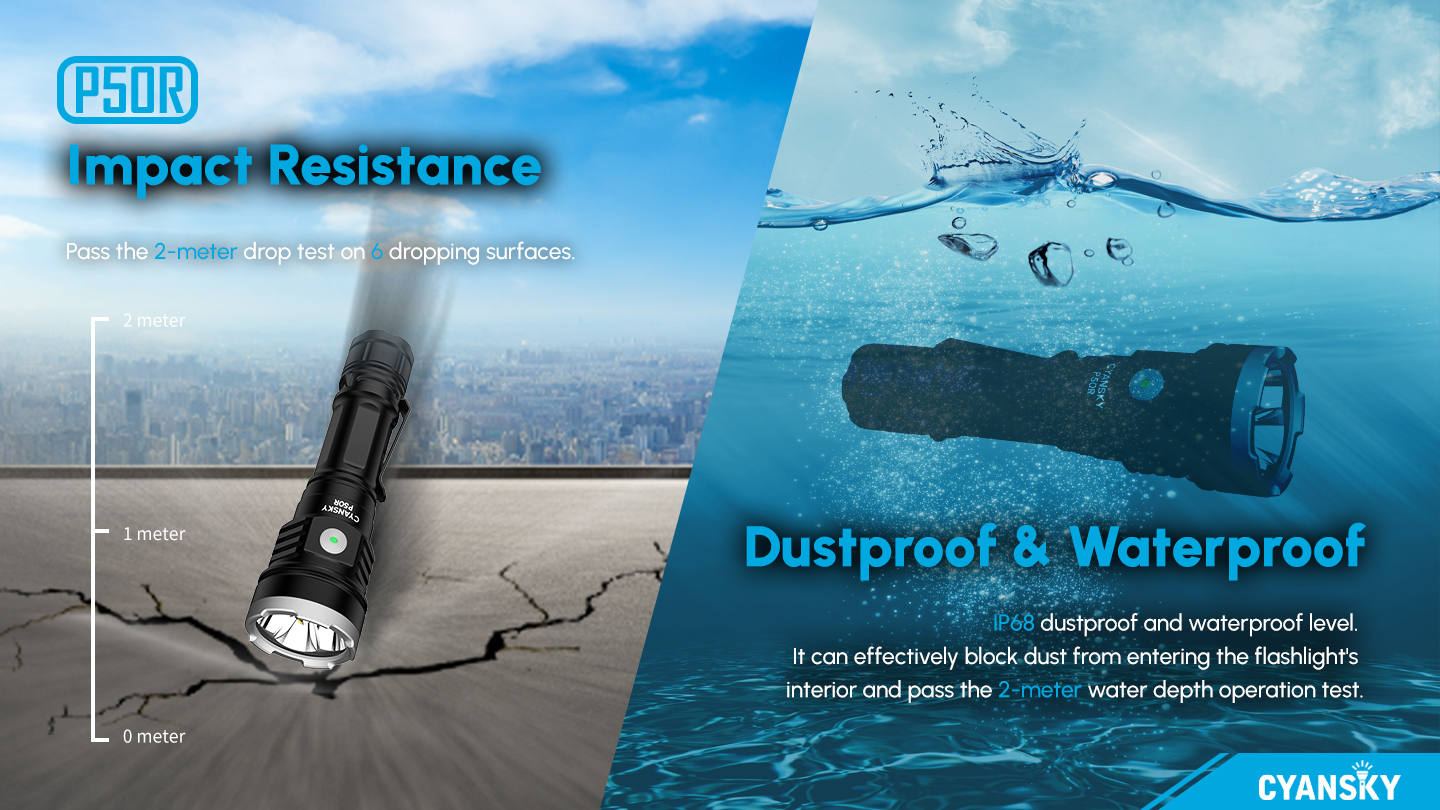Flashlights for use in extreme temperatures

When you face extreme temperatures, a reliable flashlight becomes more than just a tool—it’s a lifeline. Flashlights designed for harsh conditions ensure safety and performance in environments where ordinary devices fail. For instance, intrinsically safe flashlights operate safely in areas with flammable gases or vapors, providing consistent light output and long battery life. These features are critical for survival in challenging situations.
Extreme temperatures can damage internal components, weaken materials, and reduce battery life. Freezing cold or scorching heat can leave you stranded without light. Choosing the best survival flashlight ensures you’re prepared for emergencies, whether during a winter storm or in a high-temperature industrial setting.
Key Takeaways
Pick flashlights made from materials that handle tough temperatures. Plastic works well in heat, while strong plastics or aluminum are better for cold.
Use batteries made for extreme weather. Lithium-Manganese batteries work best in both hot and cold, giving steady power.
Get flashlights with tough, shockproof designs. Strong materials help them survive drops and rough use outdoors.
Think about brightness and beam range for outdoor needs. Flashlights with 200 to 600 lumens are good for hiking, while 600 to 1000+ lumens work well in emergencies.
Take care of your flashlight. Keep it in a cool, dry spot and clean it often so it works well in tough conditions.
Key Features to Look for in Flashlights for Extreme Temperatures

Temperature Resistance
Materials and construction for heat and cold resistance
When choosing a flashlight for extreme conditions, you need to consider its materials. Plastic polymer flashlights perform well in high-temperature environments because they conduct heat slowly. This feature protects your hands and ensures the batteries remain safe. On the other hand, metal flashlights may not be ideal for firefighting or similar tasks. Their high heat conductivity can make them unsafe to handle in hot conditions. For cold environments, reinforced plastic or aluminum flashlights provide the necessary strength and resistance to freezing temperatures.
Operating temperature ranges to consider
Flashlights designed for extreme temperatures often specify their operating ranges. The table below highlights the performance of different battery types in harsh conditions:
Battery Type | Operating Temperature Range |
|---|---|
Alkaline Primary Cells | -4°F to 130°F |
Lithium-Manganese Primary Cells | -40°F to 140°F |
Energizer Ultimate AA Lithium | -40°F to 140°F |
Selecting a flashlight with batteries that match your environment ensures reliable performance, whether you're facing a winter storm or a scorching desert.
Battery Performance
Types of batteries suitable for extreme temperatures
Battery type plays a crucial role in flashlight performance. Lithium-Manganese batteries excel in both freezing and hot conditions, offering a wide operational range. However, legacy lithium-ion batteries struggle in extreme temperatures. In cold weather, their resistance increases, reducing power delivery. In hot environments, they risk thermal runaway due to reactive processes. For the best survival flashlight, prioritize batteries designed for harsh conditions.
Rechargeable vs. disposable batteries in harsh conditions
Rechargeable batteries provide convenience and cost savings, but they may falter in extreme temperatures. Disposable batteries, such as lithium primary cells, often outperform rechargeables in these scenarios. They deliver consistent power and longer runtime, making them a reliable backup for your prepper flashlight.
Durability and Build Quality
Shockproof and impact-resistant designs
Durability is essential for flashlights used in rugged environments. Look for models with robust construction that withstand shocks and impacts. High-quality aluminum or reinforced plastic materials enhance durability, ensuring your flashlight survives drops and rough handling.
Weatherproofing and IP ratings for environmental protection
Weather resistance is another critical factor. Flashlights with rubberized seals or O-rings prevent water and dust from entering. The table below explains common IP ratings and their protection levels:
Level | Protection Against | Description |
|---|---|---|
4 | Splashing Water | Protection against splashing water from any direction |
5 | Water Jets | Protection against low-pressure water jets |
6 | Powerful Water Jets | Protection against high-pressure water jets |
7 | Immersion up to 1 Meter | Temporary immersion in water (up to 1m for 30 min) |
8 | Continuous Immersion, 1 Meter+ | Continuous immersion under specific conditions |
A flashlight with an IP rating of 7 or 8 offers excellent waterproof capabilities, ensuring reliable performance in wet or humid conditions.
Additional Features
Brightness and beam distance for outdoor use
When choosing a flashlight for outdoor activities, brightness and beam distance are two critical factors. Brightness, measured in lumens, determines how much light the flashlight produces. For general camping or hiking, a flashlight with 100 to 400 lumens works well. If you plan longer hikes or nighttime explorations, consider a range of 200 to 600 lumens. For demanding tasks like search-and-rescue, flashlights with 600 to 1000+ lumens provide powerful illumination.
Beam distance, on the other hand, measures how far the light reaches. This feature becomes essential when navigating dark trails or scanning large areas. A flashlight with 1000 to 30000 lumens can illuminate distances up to 350 meters, making it ideal for extreme weather conditions or emergencies. Whether you’re preparing for a winter adventure or assembling a survival kit, selecting a flashlight with the right brightness and beam distance ensures you stay safe and prepared.
Lumens | Beam Distance | Best Use |
|---|---|---|
100-400 | Up to 100 meters | General camping or hiking |
200-600 | 100-200 meters | Night hikes or explorations |
600-1000+ | 200-350 meters | Search-and-rescue or emergencies |
Lightweight and ergonomic designs for portability
Portability plays a significant role when you carry a flashlight for outdoor use. A lightweight flashlight reduces fatigue, especially during long hikes or extended use. Compact designs also make it easier to pack in your gear without adding unnecessary bulk.
Ergonomics is equally important. A flashlight with a comfortable grip ensures better handling, even in wet or cold conditions. Look for models with anti-slip surfaces or contoured designs that fit naturally in your hand. LED flashlights often combine lightweight construction with ergonomic features, making them a popular choice for outdoor enthusiasts. Whether you need a backup light for emergencies or a reliable tool for daily use, prioritizing portability and comfort enhances your overall experience.
Top Flashlights for Extreme Temperatures

Flashlights for Extreme Cold
Fenix PD36R
The Fenix PD36R stands out as a reliable flashlight for survival in freezing conditions. It operates efficiently in temperatures as low as -4°F, making it a dependable choice during a winter storm. Its durable aluminum body resists impacts and ensures longevity, even in harsh environments. The flashlight’s long runtime, powered by a rechargeable lithium-ion battery, provides consistent light when you need it most. With a maximum output of 1600 lumens, it delivers excellent brightness for outdoor activities or emergencies.
ThruNite TN12 Pro
The ThruNite TN12 Pro is another excellent option for extreme cold. Its LED technology performs better as temperatures drop, ensuring brighter light compared to traditional bulbs. This flashlight for emergencies features a compact design, making it an ideal addition to your bug out bag or survival kit. Lithium batteries enhance its performance, offering reliable power even in sub-zero conditions. The TN12 Pro’s weather resistance and durability make it a top choice for outdoor enthusiasts facing winter challenges.
Tip: When using flashlights in extreme cold, opt for plastic models to prevent heat loss from your hands. Always choose lithium batteries over alkaline for better runtime and reliability.
Flashlights for Extreme Heat
Skilhunt H150
The Skilhunt H150 is designed to excel in high-temperature environments. Its magnesium alloy construction provides excellent heat dissipation, ensuring consistent flashlight performance. This lightweight material also enhances portability, making it a practical choice for industrial or outdoor use. The H150 is compatible with both lithium and Eneloop batteries, offering versatility for different needs. Its waterproof design adds an extra layer of protection, ensuring reliability in humid or hot conditions.
Nitecore P20iX
The Nitecore P20iX incorporates advanced temperature regulation technology to prevent overheating. This feature adjusts the flashlight’s output based on internal temperature, protecting critical components. Ridges on the flashlight’s head improve heat dissipation, ensuring optimal performance during extended use. With a maximum brightness of 4000 lumens, the P20iX is perfect for demanding tasks in extreme heat. Its rugged build and weather resistance make it a reliable prepper flashlight for emergencies in hot climates.
Note: Flashlights with temperature regulation technology, like the Nitecore P20iX, ensure safety and durability by preventing overheating during prolonged use.
All-Weather Flashlights
Intrinsically Safe Flashlight
Intrinsically safe flashlights are engineered for versatility and safety in both extreme heat and cold. These models withstand temperatures ranging from -20°C to +40°C, making them suitable for industrial and outdoor applications. Their rugged construction resists impacts, while powerful LED bulbs provide bright, uniform illumination. These flashlights also feature extended battery life, ensuring reliable performance in emergencies.
Fenix TK20R V2.0
The Fenix TK20R V2.0 offers exceptional versatility for all-weather conditions. Its weatherproof design, with an IP68 rating, ensures protection against water and dust. This LED flashlight delivers up to 3000 lumens, making it ideal for search-and-rescue missions or outdoor adventures. Its durable aluminum body resists shocks and impacts, while the rechargeable battery provides a long runtime. Whether you face a storm or freezing temperatures, the TK20R V2.0 is a dependable flashlight for survival.
Tip: All-weather flashlights combine durability and weather resistance, making them essential tools for unpredictable environments.
Maintenance Tips for Flashlights in Extreme Conditions
Proper Storage
Storing flashlights in temperature-controlled environments
Proper storage ensures your flashlight remains functional and reliable. Always store it in a cool, dry place to prevent damage to internal components. Avoid direct sunlight and moisture, as these can lead to wear and tear. Keeping your flashlight dry helps prevent rust or corrosion, which can compromise its durability. For high-end models, consider using a protective case to shield them from physical damage.
Avoiding prolonged exposure to extreme conditions when not in use
Extreme temperatures can degrade your flashlight’s materials and reduce its performance. Avoid leaving it in freezing cold or scorching heat for extended periods. If you’re not using your flashlight for a long time, remove the batteries to prevent leakage. This simple step protects both the flashlight and its battery compartment from potential damage.
Battery Care
Tips for extending battery life in extreme temperatures
Taking care of your flashlight’s batteries is essential for survival in harsh conditions. Follow these steps to extend battery life:
Inspect batteries regularly for corrosion, leaks, or low voltage.
Clean battery terminals to improve conductivity.
Avoid short usage periods to allow batteries to recharge fully.
Store your flashlight in shaded or indoor areas to protect batteries from extreme heat.
Use a battery maintainer if you don’t use your flashlight frequently.
How to safely replace or recharge batteries in harsh environments
Replacing or recharging batteries in extreme conditions requires caution. Always keep your flashlight in a cool, dry place to prevent damage. Replace old batteries periodically to avoid leaks or corrosion. For rechargeable batteries, follow the manufacturer’s guidelines to prevent overcharging. These precautions ensure your flashlight remains a reliable backup during emergencies.
Cleaning and Weatherproofing
Cleaning methods to maintain performance
Regular cleaning keeps your flashlight in top condition. Start by removing the batteries to prevent accidental activation. Use a soft, lint-free cloth to wipe the exterior. For stubborn dirt, a damp cloth works well. Clean the threads and apply a silicone-based lubricant to maintain smooth operation. Use a microfiber cloth or lens cleaning solution to clean the lens for maximum brightness. Inspect the battery compartment and contacts to ensure they remain free of corrosion.
Applying weatherproofing treatments for added protection
Weatherproofing enhances your flashlight’s versatility and durability in extreme environments. Flashlights with an IPX7 or IPX8 rating can withstand immersion in water, making them ideal for wet conditions. High-quality seals and anti-corrosion materials protect sensitive components from moisture damage. Structural waterproofing ensures your flashlight performs reliably, even in humid or rainy weather.
Tip: Regular maintenance and weatherproofing treatments extend the life of your flashlight, ensuring it remains a dependable tool for survival and outdoor adventures.
Choosing the right flashlight for extreme temperatures ensures safety and performance in harsh environments. Extreme conditions can damage internal components and reduce battery life, so selecting a flashlight with temperature resistance, durability, and water resistance is essential. Models like the Fenix PD36R or Nitecore P20iX offer reliability for survival situations. Brightness, beam distance, and rechargeable batteries also enhance functionality during emergencies. Investing in a dependable flashlight prepares you for challenges like a winter storm, ensuring visibility and safety when it matters most.
Tip: Store your flashlight in a cool, dry place to prevent corrosion and maintain performance.
FAQ
1. What type of flashlight is best for extreme cold?
Choose a flashlight with a durable aluminum or reinforced plastic body. Look for models that use lithium batteries, as they perform better in freezing temperatures. Flashlights like the Fenix PD36R or ThruNite TN12 Pro are excellent options for cold environments.
Tip: Always carry spare lithium batteries for emergencies in cold weather.
2. Can rechargeable batteries work in extreme heat?
Rechargeable batteries can work in heat, but their performance may degrade. Lithium-ion batteries risk overheating in high temperatures. Use flashlights with temperature regulation technology, like the Nitecore P20iX, to ensure safe operation.
Note: Store rechargeable batteries in a cool place to extend their lifespan.
3. What does an IP rating mean for flashlights?
An IP rating measures a flashlight’s resistance to water and dust. For example, IP68-rated flashlights can handle continuous immersion in water and are dustproof. This makes them ideal for wet or dusty environments.
IP Rating | Protection |
|---|---|
IP67 | Temporary immersion in water |
IP68 | Continuous immersion in water |
4. How do you maintain a flashlight in extreme conditions?
Clean your flashlight regularly with a soft cloth. Inspect the battery compartment for corrosion. Apply silicone lubricant to threads for smooth operation. Store it in a dry, temperature-controlled area to prevent damage.
Tip: Remove batteries during long-term storage to avoid leaks.
5. What is the best flashlight for all-weather use?
All-weather flashlights, like the Fenix TK20R V2.0, offer durability and weatherproofing. These models withstand extreme temperatures and provide reliable performance in wet or dusty conditions. Look for an IP68 rating for maximum protection.
Reminder: All-weather flashlights are versatile tools for unpredictable environments.
See Also
Exploring Various UV Flashlights for Forensic Investigations
Your Complete Resource for Discovering Durable Flashlights
Designed for Resilience: Our Emergency Flashlight's Strength
Exploring UV Flashlights: Their Uses and Advantages
Selecting the Perfect Color Flashlight for Outdoor Adventures
